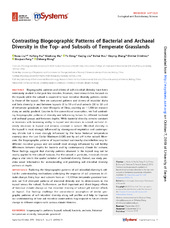| dc.contributor.author | Liu, Nana | |
| dc.contributor.author | Hu, Huifeng | |
| dc.contributor.author | Ma, Wenhong | |
| dc.contributor.author | Deng, Ye | |
| dc.contributor.author | Liu, Yuqing | |
| dc.contributor.author | Hao, Baihui | |
| dc.contributor.author | Zhang, Xinying | |
| dc.contributor.author | Dimitrov, Dimitar | |
| dc.contributor.author | Feng, Xiaojuan | |
| dc.contributor.author | Wang, Zhiheng | |
| dc.date.accessioned | 2019-11-06T14:59:42Z | |
| dc.date.available | 2019-11-06T14:59:42Z | |
| dc.date.issued | 2019-10-01 | |
| dc.Published | Liu, Hu, Ma, Deng, Liu, Hao, Zhang, Dimitrov D, Feng X, Wang Z. Contrasting Biogeographic Patterns of Bacterial and Archaeal Diversity in the Top- and Subsoils of Temperate Grasslands. mSystems. 2019;4(5):e00566-19 | eng |
| dc.identifier.issn | 2379-5077 | |
| dc.identifier.uri | https://hdl.handle.net/1956/20954 | |
| dc.description.abstract | Biogeographic patterns and drivers of soil microbial diversity have been extensively studied in the past few decades. However, most research has focused on the topsoil, while the subsoil is assumed to have microbial diversity patterns similar to those of the topsoil. Here we compared patterns and drivers of microbial alpha and beta diversity in and between topsoils (0 to 10 cm) and subsoils (30 to 50 cm) of temperate grasslands in Inner Mongolia of China, covering an 1,500-km transect along an aridity gradient. Counter to the conventional assumption, we find contrasting biogeographic patterns of diversity and influencing factors for different bacterial and archaeal groups and between depths. While bacterial diversity remains constant or increases with increasing aridity in topsoil and decreases in subsoil, archaeal diversity decreases in topsoil and remains constant in subsoil. Microbial diversity in the topsoil is most strongly influenced by aboveground vegetation and contemporary climate but is most strongly influenced by the factor historical temperature anomaly since the Last Glacial Maximum (LGM) and by soil pH in the subsoil. Moreover, the biogeographic patterns of topsoil-subsoil community dissimilarities vary for different microbial groups and are overall most strongly influenced by soil fertility differences between depths for bacteria and by contemporary climate for archaea. These findings suggest that diversity patterns observed in the topsoil may not be readily applied to the subsoil horizons. For the subsoil in particular, historical climate plays a vital role in the spatial variation of bacterial diversity. Overall, our study provides novel information for understanding and predicting soil microbial diversity patterns at depth. | en_US |
| dc.language.iso | eng | eng |
| dc.publisher | American Society for Microbiology | eng |
| dc.rights | Attribution CC BY | eng |
| dc.rights.uri | http://creativecommons.org/licenses/by/4.0/ | eng |
| dc.subject | biogeographic patterns | eng |
| dc.subject | topsoil | eng |
| dc.subject | subsoil | eng |
| dc.subject | bacteria | eng |
| dc.subject | archaea | eng |
| dc.subject | historical temperature anomaly | eng |
| dc.subject | temperate grassland | eng |
| dc.title | Contrasting Biogeographic Patterns of Bacterial and Archaeal Diversity in the Top- and Subsoils of Temperate Grasslands | eng |
| dc.type | Peer reviewed | en_US |
| dc.type | Journal article | en_US |
| dc.date.updated | 2019-10-24T17:24:58Z | |
| dc.description.version | publishedVersion | |
| dc.rights.holder | Copyright 2019 Liu et al. | eng |
| dc.identifier.doi | https://doi.org/10.1128/msystems.00566-19 | |
| dc.identifier.cristin | 1740395 | |
| dc.source.journal | mSystems | |

